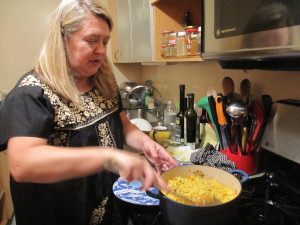[vc_row][vc_column][vc_column_text] [/vc_column_text][/vc_column][/vc_row][vc_row][vc_column width=”1/1″][vc_column_text]
RECIPES | SCHOLARS | MUSIC | EXTRAS | LINKS
[/vc_column_text][/vc_column][/vc_row] [metaslider id=2070]
Story #3: Hidden Kitchens Russia—Communal Kitchens
[audio: https://kitchensisters.org/audio/Hidden_Kitchens_Communal%20Kitchens_MIX_032414.mp3]In the decades following the Russian Revolution, most people in Moscow lived in communal apartments; seven or more families crammed together where there had been one, sharing one kitchen and one bathroom. The spaces were crowded, stove space and food were limited. Clotheslines were strewn across the kitchen, the laundry of one family dripping into the omelet of another.
As the Soviet Union industrialized and millions poured into Moscow from the countryside, one of the goals of the new government was to provide housing for the workers. They started putting people into apartments that had been occupied by the Russian rich or aristocrats who had been driven out by the new regime.
“The communal apartment was like a microcosm of Soviet society,” says Anya von Bremzen, author of Mastering the Art of Soviet Cooking. “People from all walks of life, sometimes absolute class enemies, living next to each other. The expression was ‘densed up.’ The allotment was nine square meters per person.”
Gregory (Grisha) Freidin, professor of Russian literature at Stanford University, grew up in a communal apartment of 10 families about five blocks from the Kremlin. “On one side of my room was the man who washed corpses at the local morgue. There were two rooms where the mother and father served in the KGB. Then there was the woman whose husband was serving a sentence for stealing bread from the bread factory where he worked.”
In Grisha’s kitchen, every family had a small kitchen table that housed a few pots and pans. There were two four-burner stoves. Everyone cooked their own food — cabbage soup, borscht with beets, potatoes, buckwheat groats, boiled chicken.
Communal Kitchen was a War Zone
Kitchens became a source of tension and conflict. “Five different kettles, five different pots that are all marked,” remembers Edward Shenderovich, venture investor and Russian poet. “When relations between the neighbors were especially fierce, you could see locks on the cabinets.”
Families cooked in quick, staggered shifts. “They cooked in the kitchen but practically never ate there,” says Masha Karp, who was born in Moscow and worked for the Russian Service of the BBC. “They would go with their pots along their corridor and eat in their room.”
“Communal kitchen was a war zone, Alexander Genis Russian writer and radio journalist. “During the Stalin era it was the most dangerous place to be in the kitchen.”
“Communal kitchens were not places where you would bring your friends,” says Edward Shenderovich. “I think that was one of the ideas for creating a communal kitchen. There would be a watchful eye of society over every communal apartment. People would report on each other. You would never know who would be reporting.”
But Anya von Bremzen remembers there was camaraderie as well. “There was always a grandmother to take care of the kids, and share a bit of cutletta or salat Olivier. And when they began to disband the communal apartments, the communal kitchen was an institution that many people actually began to miss.”
The Soviet authorities considered kitchens and private apartments dangerous to the regime because they were places people could gather to talk about politics.
“The most important part of kitchen politics in early Soviet time, was they would like to have houses without kitchens,” says Alexander Genis. “Because kitchen is something bourgeois. Every family, as long as they have a kitchen, they have some part of their private life and private property.”
Houses Without Kitchens
The Soviet authorities considered kitchens and private apartments dangerous to the regime because they were places people could gather to talk about politics.
“The most important part of kitchen politics in early Soviet time, was they would like to have houses without kitchens,” says Alexander Genis, Russian writer and radio journalist. “Because kitchen is something bourgeois. Every family, as long as they have a kitchen, they have some part of their private life and private property.”
Soviet planners designed and built apartments without kitchens. Residents were expected to eat all of their meals in large cafeterias and public canteens.
Sergei Khrushchev, retired Brown University professor and son of Nikita Khrushchev, the head of the Soviet Union from 1953 to 1964, explains: “In Stalin’s time, the theoretical idea of communism declared that all people have to be equal and the women have to be free from the slavery work in the kitchen. There mustn’t be a kitchen in the apartment. You will go and eat in the cafeteria.”
This was part of the romantic approach of the early post-revolutionary years, says Masha Karp. “People forget what an incredible upheaval the 1917 revolution was,” she says. “There was a huge movement to free the country from the Czarism, bring happiness to poorer classes. People thought maybe it was a good idea to relieve a housewife from her daily chores so that she could develop as a personality. She would go and play the piano, write poetry, and she would not cook and wash up. The idea to have canteens and cafeterias was a continuation of this wonderful intention.”
But the cafeteria idea did not pan out. After the revolution, the civil war began and they did not build any cafeterias. Also, Anya von Bremzen tells us, the food in the canteens was terrible, and women continued to cook.
“Bolsheviks were not into food. Lenin was not a foodie,” says von Bremzen. “They saw it as fuel, they had to feed the workers. The Bolsheviks kind of wanted to eradicate privacy. And private hearth, private stove becomes very politicized.”
The Industrialization of Food
Food shortages and the famine of the 1920s devastated whatever was left of the Russian kitchen. Stalin’s industrialization program included the industrialization of food. Completely new, mass produced food appeared.
“The whole of the Soviet Union, all 120 different ethnic groups were suddenly being served exactly the same stuff,” says Grisha Freidin. “Choices for this or that food, the tastings, took place at the politburo level. The kinds of candies that were being produced was decided in a special meeting with Stalin and Molitov.”
The Kitchen Debates
With the death of Stalin in 1953 and the ramping up of the Cold War, the Soviet Union’s goal was to catch up and overtake the United States. In 1959 Khrushchev decided to have a cultural exchange of exhibitions with the United States, the first in history.
The Soviet Union’s display in the New York Coliseum featured sputniks, a model of an atomic ice-breaker and enormous statues of Soviet workers.
The US built a huge pavilion in Moscow’s Sokolniki Park, a futuristic geodesic dome featuring American jazz, basketball, rows and rows of high heeled shoes, abstract art, long sleek American cars. The exhibition introduced never-before seen or tasted American products to the Soviet people.
For many Soviet visitors to the exhibit, Pepsi Cola stole the show. “Every visitor would pass the counter where Pepsi Cola was given out in disposable paper cups,” remembers Grisha Freidin, who was 13 years old at the time. A decade later, an historic deal was negotiated that brought Pepsi to Russia. “Pepsi was the first American company, even before McDonald’s, to get their foot in the door. Part of the deal between Pepsi Cola and the Soviet Union was that Pepsi would be given the distribution rights for Stoli, Stolichnaya Vodka,” says Freidin.
At the center of the U.S. exhibit was a “typical American home” with a “typical American kitchen.” It had gleaming white refrigerators, washing machines and all the latest electric appliances.
When Vice President Nixon arrived to open the Pavilion, it was in this model Betty Crocker kitchen that he and Nikita Khrushchev made an unscheduled stop and came head to head in what is now known as “The Kitchen Debates. “
“They go to this kitchen,” remembers Sergei Khrushchev, “and Nixon talks about American achievement and my father talks about Soviet achievement. They argue with each other about which system is better.”
Nixon asks Khrushchev if it would not be better to compete in the relative merit of washing machines rather than in the strength of rockets. He counters, saying “And this is one of the greatest nations? I feel sorry for America judging by your exhibition. Does your life really consist only of kitchens?”
The threat of atomic warfare, economic progress and diplomacy were all examined through the lens of the kitchen. “Nixon and Khrushchev talked about food,” says the Russian writer Alexander Genis, “how people live, how people eat.”
Back to top [vc_column width=”1/1″][/vc_column][vc_column_text][/vc_column_text][symple_divider style=”solid” margin_top=”20px” margin_bottom=”20px”]
Communal Kitchen Recipes
[symple_tabgroup] [symple_tab title=”Salat Olivier “]
Salat Oliver from Mastering the Art of Soviet Cooking: A Memoir of Food and Longing by Anya Von Bremzen Serves 6
Salad3 large boiling potatoes, peeled, cooked, and diced |
Dressing1 cups Hellmann’s mayonnaise, or more to taste |
1. In a large mixing bowl combine all the salad ingredients and season with salt and pepper to taste.
2. In a medium bowl, whisk together all the dressing ingredients, season with salt, and taste: it should be tangy and zesty. Toss the salad throughly with the dressing, adding a little more mayo if it doesn’t look moist enough. Adjust the seasoning to taste. Serve in a cut-crystal or glass bowl. [/symple_tab] [symple_tab title=”Moscow-Style Borshch“]
Moscow-Style Beet Soup from A Taste of Russia by Darra Goldstein
3 quarts
2 pounds of beef shin or beef chuck with bone
9 cups water
3 medium beets, peeled and cut in half
1 to 1/2 tablespoons salt (to taste)
2 medium potatoes, peeled and cubed 1 small carrot, scraped and grated
1/2 medium head of white cabbage (3/4 pound), shredded
1 ripe tomato, coarsely chopped
6 tablespoons tomato paste
4 black peppercorns
Freshly ground black pepper
2 tablespoons wine vinegar
1 teaspoon sugar
1 bay leaf
Sour Cream
1. Simmer the meat in the water for 30 minutes. Then add the beets and salt. Boil for 10 minutes more.
2. Remove the beets from the broth and grate coarsely. Then return to the pot and add the remaining ingredients except the bay leaf and sour cream.
3. Simmer the soup until done, about 1 1/2 hours. Remove from the heat and add the bay leaf. Let the soup cool to room temperature, then chill overnight. Next day, skim off the fat and reheat. Put a slice of meat and a dollop of sour cream in each bowl. [/symple_tab]
[symple_tab title=”Barrel-Style Dill Pickles“]
Barrel-Style Dill Pickles from A Taste of Russia by Darra Goldstein
8 pounds of unwaxed pickling cucumbers
2 fistfuls fresh dill with seeds (about 40 sprigs)
1 pound pickling salt (1 1/2 cups)
6 quarts water
2 whole heads of garlic, peeled, the cloves halved (about 18 cloves)
3 teaspoons whole black peppercorns
2 teaspoons crushed dried hot pepper (or 10 small hot red peppers)
3 teaspoons coriander seed
2 teaspoons mustard seed
8 bay leaves
Thick chunk of rye bread (without preservatives)
1. Wash a 2-gallon crock or barrel. Wash the cucumbers, making sure that none of them have brown spots of bruises. Place half of the dill on the bottom of the crock. Stand the cucumber on end in the crock as tightly as they will fit, in a single layer.
2. Dissolve the pickling salt in the water and pour half of it over the cucumbers. Add half of the garlic, peppercorns, hot pepper, coriander seed, mustard seed and bay leaves.
3. Pack the remaining cucumbers into the crock, standing them on end. Add the rest of the salt water, spices and dill. Place the chunk of rye bread on top. The salt water should completely cover the pickles. Run the blade of a knife down into the crock a few times to make sure there are no pockets of air. If the salt water does not cover the cucumbers, add a little more in the same proportions.
4. Place a saucer over the pickles, laying it right in the brine, and place a heavy weight on tope of the saucer. Then cover the crock loosely with a cloth. Once again, make sure the cucumbers are completely immersed in the brine.
5. Keep the crock at room temperature, about 70 degrees F. Every day remove any scum that has formed on top of the brine, each time washing out the cloth, then replacing the saucer, weight and cloth.
Half-sour pickles will be ready in 3 to 4 days. For fully soured pickles, wait 8 to 9 days. When the pickles are as sour as you like, pack them into jars, along with the brine and spices, and refrigerate.
[/symple_tab] [/symple_tabgroup] Back to top [symple_divider style=”solid” margin_top=”20px” margin_bottom=”20px”]
Humanists & Scholars
For additional academic references, please see the following publication:
Caldwell, Melissa L., Elizabeth C. Dunn, and Marion Nestle. Food & Everyday Life in the Postsocialist World. Bloomington: Indiana UP, 2009. Print. Read excerpt here
Back to top [symple_divider style=”solid” margin_top=”20px” margin_bottom=”20px”]
Music
Songs featured in Communal Kitchens
- Quartet No. 8: III Allegretto, composer, Shostakovich, Black Angels, Kronos Quartet
- Marionettes, Memories of Childhood. Composer, Julius Isserlis. Sam Haywood (piano), Hyperion.
- Symphony of Sirens, composer, Arseny Avraamov. Directd by Leopoldo Amigo and Miguel Molina
- Once in Autumn, Memories of Childhood. Composer, Julius Isserlis. Sam Haywood (piano), Hyperion.
- Couple in a Café, from the film Seventeen Moments of Spring, composer Mikael Tariverdiev
- From Charles and Ray Eames “Glimpses of USA” film
[symple_divider style=”solid” margin_top=”20px” margin_bottom=”20px”]
Extras
Charles Maynes
Anya Von Bremzen
Alexander Genis
Alexander Genis is a Russian-American writer, broadcaster, and cultural critic. He has written more than a dozen books that are non-fiction bestsellers in Russia. Genis, an American citizen, now resides in the New York City area.
Ilya Kabakov
Ilya Kabakov, a Russian conceptual artist based in Moscow, achieves a holistic representation of Soviet life in his “total installations.” In his recent work, “La Cuisine Communautaire” or the Communal Kitchen, which was shown at the Musee Maillol in Paris, Kabakov arranges everyday objects in haphazard patterns that mimic the disarray of daily life. These objects are spread through several rooms, each room belonging to another one of Kabakov’s imagined “characters.” Rather than diminishing its focus, the variety of personalities present bring Kabakov’s work to life—there is the sense of being on a street corner in Moscow rather than in a museum. All of these personalities, crafted with posters and shoes and sheets, are represented in the communal kitchen installations. Kabakov’s kitchens complete his theme of individual lives coming together to make a new world, as Russians of varying ages and occupations would have gathered together in the kitchen to make food and ideas. Kabakov’s communal kitchen is littered with pots and pans and dishtowels, evoking the number and variety of participants in this cramped culinary ritual.
“There were no warriors, no revolutionaries except for five or six dissidents. Life consisted of two layers, each person was a schizophrenic. Any person—a factory worker, farm worker, intellectual, artist—had a split personality. From childhood, everyone knew what was necessary in order to survive in this country—how you had to lie, how to adapt, what to draw, what to sing, how to dance. By the 1950s, the entire repertoire, the whole menu, was sketched out; by then there were no discussions at all, like there were during Mayakovsky’s time. This was so monstrously false, that underneath this bark emerged an autonomous layer of a different kind of human existence. For stealing from the factory, a worker could be very honored inside his own family. He would teach his child decency, but each day he would bring home a stolen sausage or milk. This was the norm in Soviet life. For the external world there was one structure—mostly verbal, chatter, all those meetings, the battle for peace. And then there was “human” life that transpired in the kitchen, among one’s close family and friends. In the 1950s, it was possible to talk among one’s close friends in kitchens, by that time there was a guarantee that no one would run and tattle about what was discussed there. After the death of the Cannibal1 this dual life became firmly established, it was recognized by absolutely everyone, including the official organs of the secret police. There was a very strict distinction between public and domestic, kitchen life.” – Ilya Kabakov
Life in a Communal Apartment

[symple_divider style=”solid” margin_top=”20px” margin_bottom=”20px”]
Links
 |
 |
|||
| Communal Living in Russia: A Virtual Museum of Soviet Everyday Life http://kommunalka.colgate.edu/index.cfm |
Kommunalki http://riowang.blogspot.com/2011/07/kommunalki.html |









